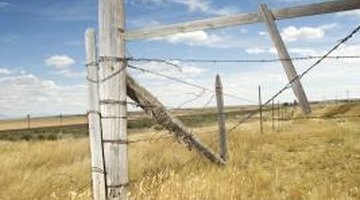How to Install Posts in a High Water Table Area
A high water table makes installing posts for fencing, decks, mailboxes and other applications more challenging but not insurmountable. If, after digging a post hole, standing water appears in the bottom of the hole, this is a strong indication of a high water table. A few extra steps and added supplies can easily resolve the problem.

Step 1
Dig a hole at least 42 inches deep and 12 inches wide. Taller fence posts, deck supports and similar posts will require deeper holes. Most experts recommend a depth equal to one-third the length of the post.
Step 2
Pour in large pea gravel to an approximate depth of 3 inches or more. Tamp down with the end of one post.
Step 3
Pour in an equal amount of small-grade pea gravel. Five to 6 inches will suffice, depending on local codes. Tamp down with the end of a post.
Step 4
Insert a post into a post hole and position it until level. Backfill with dry concrete mix, leaving the last six inches for dirt. Tamp around the post with a wide stick or tamping tool.
Step 5
Backfill the remaining space with dirt. Tamp firmly with a tamping tool or boot heel. Let stand 48 hours or more, depending on local conditions.
References
Tips
- No fence or other type of post is intended to last forever. Accommodating for high water tables is intended only to extend the life of a particular post.
- Gravel helps drain water from the underground section of a post to prevent the water from rotting the post. Concrete provides a wider base to disperse any shifting caused by wind, gates or other pressure.
Warnings
- Verify local ordinances and state regulations, as these often list requirements specific to local conditions.
- If sealants are used to coat and further waterproof the section of post below ground, seal only the sides of the post. Leaving the underside of the post unsealed allows water to drain through the length of the post.
Writer Bio
Sandra Johnson is a freelance writer, ghostwriting for private clients since 2006, and writing for print and online publications such as Sashay Magazine. She has studied with both Kaplan and Colorado Technical universities for bachelor's degrees in both human resources and accounting. In addition to writing, Johnson also operates a small family farm in rural Georgia.
Photo Credits
- Jupiterimages/Comstock/Getty Images
More Articles



